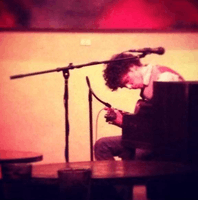Ben Cosgrove
Ben Cosgrove (born 30 January 1988) is an American composer and multi-instrumentalist from Methuen, Massachusetts, whose work mainly explores the intersection of sound and place.[1]
Ben Cosgrove | |
|---|---|
 Cosgrove playing live in Boulder, Colorado in 2013 | |
| Background information | |
| Born | January 30, 1988 |
| Genres | Instrumental |
| Occupation(s) | Composer, Multi-instrumentalist, Producer |
| Instruments | piano, keyboards, organ, accordion, upright bass, guitar, percussion, trumpet, trombone, euphonium, violin, field recordings |
| Years active | 2010–present |
| Website | bencosgrove.com |
Background
Cosgrove is a 2010 graduate of Harvard College, where he was a student of Hans Tutschku, and his music usually features his own performances on piano, guitar, mandolin, banjo, violin, trumpet, trombone, upright bass, and dynamic percussion, among other instruments.[2]
Cosgrove's first instrument was the piano. He began taking lessons as a young child after his family moved into a house and his parents purchased an upright.[3] In addition to his solo work, he often tours and records with other artists and has frequently served as the touring keyboardist/accordionist for fellow New Englanders The Ghost of Paul Revere. [4] [5]
Releases
His 2011 album Yankee Division is based upon landscapes around Massachusetts and the rest of New England and takes its name from the Yankee Division Highway.[6] His fourth album Field Studies deals with the wider American landscape, from the Sierra Nevada to the Everglades.[7] It was released in January 2014.[8]"It’s instrumental music intended to suggest the experience of certain physical landscapes," he stated in an interview with Sound of Boston.[9] The album's first track, “Lafayette” is written about Mount Lafayette in New Hampshire; the song is meant to recreate the moment in the hike when “you get above the clouds and have a unique kind of clarity.”[10]
In 2014, he produced the album Ellery for singer-songwriter Max Garcia Conover, composing and performing arrangements to underpin Conover's melodies.[11]
In 2015, Cosgrove released a live album, "Solo Piano," which features recordings collected from performances in thirteen different states.[12] One reviewer called it "a humbling reminder of just how much emotion can be conveyed without a word on a solo piano that is expertly played."[13]
His latest studio album, "Salt," a concept record comparing landscapes of flux and ambiguity to personal tumult and emotional unrest, came out in the spring of 2017 and was described by Sound of Boston as "the human condition set to gorgeous, lush piano."[14][15] In Junction Magazine, reviewer James Napoli wrote that the music represented "a poetry of tones and turns and motion and play that transcends the gross signification of everyday language[...] Cosgrove’s music is about landscape, about place, about space. It reacts and responds and reflects and resonates in space. It creates and transforms space. This album, specifically, is about instability, uncertainty, liminality, disorientation. It’s about the unhinged feeling that comes from losing the solid ground on which one has comfortably and complicitly stood for too long, about the realization that the safety provided by such footholds is always illusory, and about learning to live with the shifting, floating impermanence that was there (and not there), enveloping us all along. It’s a break-up album. And it’s also a salve."[16]
Literature
Cosgrove also writes nonfiction essays that touch upon place, sound, and art.[17] He began selling a short collection, Seven Essays, at performances and online in early 2016, and his writing has appeared in Orion, Northern Woodlands, and other magazines.[18][19][20] He was a two-time artist in residence at the Signet Society and has also served as the artist-in-residence at Isle Royale National Park, Acadia National Park, and White Mountain National Forest.[21][22][23]
References
- Patrick Lauppe (2012-10-17). "Harvard Arts Blog » Ben Cosgrove '10 talks music, national parks and urgent signals". Ofa.fas.harvard.edu. Archived from the original on 2014-02-03. Retrieved 2014-02-02.
- "Composer and musician Ben Cosgrove portrays place in "Yankee Division," a new CD | Harvard Magazine Jul-Aug 2012". Harvardmagazine.com. 2013-09-25. Retrieved 2014-02-02.
- Atlas, Zoe. "Local Spotlight: The Soundscapes of Ben Cosgrove". Sound of Boston. Retrieved 16 November 2014.
- "Live Music featuring Ben Cosgrove". Retrieved 2019-08-15.
- "The Ghost of Paul Revere on Instagram". Retrieved 2019-08-18.
- "» Desktop Submissions: Ben Cosgrove's Yankee Division". Residentmediapundit.com. Archived from the original on 2014-02-19. Retrieved 2014-02-02.
- "Ben Cosgrove | Field Studies | CD Baby Music Store". Cdbaby.com. Retrieved 2014-02-02.
- Ben Cosgrove. "Store". ben cosgrove. Retrieved 2014-02-02.
- Atlas, Zoe. "Local Spotlight: The Soundscapes of Ben Cosgrove". Sound of Boston. Retrieved 16 November 2014.
- Atlas, Zoe. "Local Spotlight: The Soundscapes of Ben Cosgrove". Sound of Boston. Retrieved 16 November 2014.
- "Max Garcia Conover". Retrieved 2014-10-22.
- "Red Line Roots: Ben Cosgrove - Solo Piano review". Retrieved 2015-12-13.
- "Red Line Roots: Ben Cosgrove - Solo Piano review". Retrieved 2015-12-13.
- "Red Line Roots: Ben Cosgrove - Shifting Landscapes". Retrieved 2017-06-29.
- "Sound of Boston: Album Review - Salt by Ben Cosgrove". Retrieved 2017-06-29.
- "Junction Magazine: Review - Salt". Retrieved 2017-06-29.
- "A Different Kind of Interstate". Landthatilive.com. 2012-10-24. Retrieved 2014-02-02.
- "Seven Essays". Bencosgrove.com. 2016-04-05. Retrieved 2016-05-02.
- "Orion Magazine: The Sound of Six Million Acres". Retrieved 2017-06-29.
- "Northern Woodlands: An Ice Storm Comes to Hubbard Brook". Retrieved 2017-06-29.
- "Ben Cosgrove". The Signet Society. 2012-04-20. Retrieved 2014-02-02.
- "About Ben - Ben Cosgrove". www.bencosgrove.com. Retrieved 2014-10-29.
- "Ben Cosgrove - Artist in Residence". Archived from the original on 2015-12-22. Retrieved 2015-12-13.